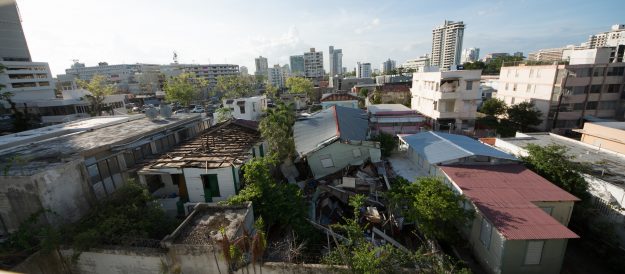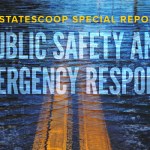Why Puerto Rico still doesn’t know how many people died in Hurricane Maria

The official death toll from Hurricane Maria, the Category 4 storm that devastated Puerto Rico last September, stands at 64. For months, that figure has stood as laughably low compared to outside estimates by news organizations and medical surveys. A New York Times analysis last December pinned 1,054 fatalities on Maria. Similar reports by CNN, BuzzFeed and Pennsylvania State University came up with similar numbers.
And last week, researchers led by the Harvard T.H. Chan School of Public Health published a study in the New England Journal of Medicine estimating Maria claimed at least 4,645 lives .
The chasmic difference in mortality figures — even before the Harvard report — emerged because the Puerto Rico government’s official count only includes deaths that happened during the actual storm, such as people killed by flying debris. But Maria was only the beginning of Puerto Rico’s ordeal: blackouts, a lack of clean water and roads made impassible after the storm passed created conditions in which people who needed food or urgent medical care couldn’t get it in time.
Meanwhile, the one agency on the island that could potentially produce an accurate accounting of the hurricane’s human cost is set to lose its independence as Puerto Rico’s cash-strapped government prepares to undergo a major reorganization.
The Puerto Rico Institute of Statistics, or PRIS, has been the island’s independent data-collection and -analysis agency since it was established in 2007. Over the past decade, it’s been credited with improving how Puerto Rico tracks its mortality rate and combats fraud in government programs. Its leaders want to conduct an intensive study of deaths in the wake of Hurricane Maria. But they might not get that chance if a plan to consolidate PRIS under the commonwealth’s Department of Economic Development and Commerce (DEDC) takes effect.
Being placed under DEDC would rob PRIS of its ability to direct its own work, potentially stripping it of the ability to accurately count deaths caused by Maria and future hurricanes, Mario Marazzi, PRIS’s executive director, told StateScoop. A government agency run by a political appointee focused on Puerto Rico’s economy is not an ideal venue in which to compile statistics about life and death, Marazzi said.
As an independent body, PRIS is overseen by a seven-person board. But a plan approved last month by Puerto Rico’s legislature would eliminate that group and put PRIS under the oversight of the secretary of economic development, who is appointed by the commonwealth’s governor.
“Fast forward on that,” Marazzi said. “The secretary sends someone in. Then you have to ask, do you really think the department of economic development is going to give much priority to something that addresses mortality?”
The need for a case-level study
PRIS very much wants to study Hurricane Maria. On April 24, its board issued a resolution approving the use of the Centers for Disease Control’s methodology in recording natural-disaster fatalities, a practice that counts indirect deaths like those that result from “unsafe or unhealthy conditions present during any phase of the disaster.” That encompasses the phases when the vast majority of deaths is believed to have occurred.
“CDC has produced a lot of information on how to identify indirect deaths,” Marazzi said. “It’s been applied to Hurricane Katrina and Ike. It’s been applied all over, and there’s no reason it can’t be applied here.”
But a big reason no such study has been done after Hurricane Maria is because doing so would require case-level epidemiology that Puerto Rico might not be able to afford. The island has been under a federally authorized financial control board since 2016, and last year declared bankruptcy under $73 billion in municipal debt.
Puerto Rican legislators have until June 30 to approve legislation enabling a government reorganization plan. The one currently on track to be adopted consolidates PRIS, despite opposition not just from the institute itself, but from a bipartisan congressional task force established by Congress in 2016.
“Recognizing that the government of Puerto Rico faces a difficult fiscal environment, the Task Force recommends that the government of Puerto Rico considers appropriating a level of funding to the Puerto Rico Institute of Statistics that is commensurate with its important responsibilities,” the task force wrote in a December 2016 report .
The financial control board sounded as supportive in February, when it sent a letter to Gov. Ricardo Roselló supporting PRIS’s continued existence. “Maintaining the PRIS as a standalone, independent agency of the Government of Puerto Rico is essential to ensuring the transparency and credibility of the Government’s statistics,” the board wrote in its letter .
In defending PRIS’s independence, both the congressional task force and control board cited the institute’s record in being accurate where other government accounting fell short, particularly where human lives are concerned. Between 2009 and 2011, for instance, PRIS re-evaluated Puerto Rico’s murder count and found that the island’s police and forensic-science agency undercounted the homicide rate by nearly 10 percent. Other studies are credited with saving the commonwealth and federal governments more than $10 million from Medicaid abuse. The institute also operates data.pr.gov , which catalogs information collected from across the island’s government.
What makes the fight over PRIS all the more confounding is that its accomplishments have been made on the cheap. Despite official recommendations that it receive $5 million in annual funding, Puerto Rico’s legislature has typically appropriated only between 20 and 25 percent of that funding, out of a total commonwealth budget that runs about $22 billion.
Rosselló announced Feb. 22 that Puerto Rico had hired researchers at George Washington University to review death records since Maria in order to come up with a closer estimate of the storm’s actual toll. That review is costing the island’s government about $305,000. A second phase, analyzing individual cases, is estimated to cost about $1.1 million, but funding has not been allocated.
The Harvard study did that kind of case-level work. Researchers came up with their estimated death toll after surveying 3,300 randomly selected homes across Puerto Rico, and running their mortality rates against 2016’s year-end statistics. Marazzi said PRIS could afford to conduct that kind of epidemiological deep dive, if it remains independent.
“We don’t have a lot of money, but we have some savings we’ve accumulated for big statistical projects,” he said. “We could build an army of student interns to review case files.”
But as much as it shed light on Maria’s devastation, the Harvard report opened a new battle for PRIS. A day after the report’s release, PRIS sued Puerto Rico’s health and demographics agencies to turn over information related to Maria. On Tuesday, a San Juan judge ordered the government to comply. It’s far from the first time PRIS has tangled with Rosselló.
A history of political meddling
But when it comes to investigating the effects of hurricanes, PRIS has been hamstrung before. Even before the current consolidation argument, the institute was effectively out of commission for seven months — including hurricane season — after Rosselló fired four scientists from its seven-member board of directors last July. PRIS sued to reverse the governor’s move and eventually won in court. But without a functioning board, the institute was unable to develop plans that could’ve possibly helped tally up the storm damage or repair Puerto Rico’s electrical grid more quickly.
Rosselló’s attempted trifling with the PRIS board also flies in the face of his reputation as being more innovation-friendly than his predecessors. For one thing, he restored Puerto Rico’s chief information officer position after it was eliminated by his predecessor, Alejandro Padilla.
“You cannot have governors who don’t have an understanding of digital to rebuild a country properly,” said Giancarlo Gonzalez, Puerto Rico’s CIO when Padilla abolished the office. “I believe Rosselló fully supports this.”
Under Rosselló, the new CIO, Luis Arocho, operates out of a politically independent information technology office. Arocho has spoken of his own difficulties after Hurricane Maria , including having to manage gasoline and cash shortages on top of getting the island’s communications systems running again. Since Maria, he’s set about modernizing Puerto Rico’s tech infrastructure to make it more resilient against the next storm.
Gonzalez, who is now a consultant, told StateScoop that if PRIS is fated to be consolidated under another agency, it should be Arocho’s. “Then you’re transforming the statistics institute to become an engine of innovation,” he said.
But the current plan, to which the financial control board has given its blessing, puts PRIS under economic development. In a statement to StateScoop, the board’s executive director, Natalie Jeresko, expressed concern for reliable statistical research, but did not say anything specifically about PRIS’s fate.
“The oversight board continues to be concerned regarding the need to ensure the quality and credibility of Puerto Rico’s economic statistics,” Jeresko said. “We are hopeful that the government of Puerto Rico will address those concerns, within the framework of its reorganization plan, to achieve the shared goal of producing consistent, credible and current statistical data.”
The board did not respond to questions about why it shifted its position on preserving PRIS’s independence, but if the legislature passes enabling legislation, the institute is not confident it’ll be able to continue its work.
“What really makes me mad is that I’ve been in Puerto Rico government for 10 years and I’ve seen every government try to fudge the numbers every which way,” Marizzi said. “After Hurricane Maria, there’s a lot of federal investment and the American taxpayer needs to know their money is well-spent.”
The 2018 hurricane season began June 1, and some forecasters predict it will be as active as 2017’s.

This story was featured in StateScoop Special Report: Public Safety & Emergency Response (2018)





